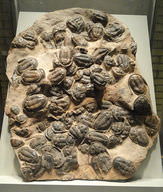15.3: Earth History and Clues from Fossils
- Page ID
- 5577
How could there be seashells at 20,000 feet?
Shell beds are found high in the Andes Mountains. How did they get there? This is more evidence that Earth is a dynamic planet! The rock that is on top of the mountains was once beneath the sea. Due to plate tectonics, the mountains rose slowly above the ocean. This process took a really long time. This is one way we know that Earth is really old!
Learning from Fossils
Of all the organisms that ever lived, only a tiny number became fossils. Still, scientists learn a lot from fossils. Fossils are our best clues about the history of life on Earth.
Fossil Clues
Fossils give clues about major geological events. Fossils, like the one pictured below (Figure below), can also give clues about past climates. Here are just a few examples.
- Fossils of ocean animals are found at the top of Mt. Everest. Mt. Everest is the highest mountain on Earth. These fossils show that the area was once at the bottom of a sea. The seabed was later uplifted to form the Himalaya mountain range.
- Fossils of plants are found in Antarctica. Currently, Antarctica is almost completely covered with ice. The fossilized plants show that Antarctica once had a much warmer climate.
What can we learn from fossil clues like this fish fossil found in the Wyoming desert?
Index Fossils
Fossils are used to determine the ages of rock layers. Index fossils are the most useful for this. Index fossils are of organisms that lived over a wide area. They lived for a fairly short period of time. An index fossil allows a scientist to determine the age of the rock it is in.
Trilobite fossils (Figure below) are common index fossils. Trilobites were widespread marine animals. They lived between 500 and 600 million years ago. Rock layers containing trilobite fossils must be that age. Different species of trilobite fossils can be used to narrow the age even more.
Trilobites are good index fossils. Why are trilobite fossils useful as index fossils?
Further Reading
Principles of Relative Dating
Determining Relative Ages
Correlation Using Relative Ages
Summary
- Fossils tell a lot about the environment during the time they were deposited.
- Climate is one important thing that can be indicated by fossils. This is because organisms have specific conditions in which they can live.
- An index fossil must be distinctive, widespread, and short-lived. It indicates a specific period of time.
Review
- How do fossils help geologists learn about the geological history of an area?
- How is an index fossil used to identify a time period?
- Why are the fossils of marine organisms sometimes found in rock units at the tops of high mountains? What does this tell you about the geological history of an area?
Explore More
Use the resource below to answer the questions that follow.
- Why is the paleoecologist collecting samples?
- What does he want to create from the fossil evidence?
- How is this similar to forensic science?
- What do they look for to understand insect feeding?
- What has been discovered from these fossils?
- What question does this raise for the scientists?




